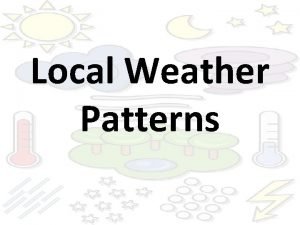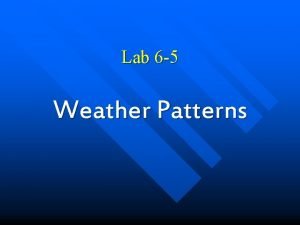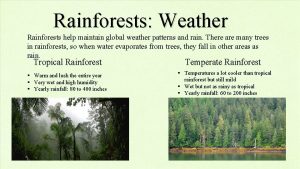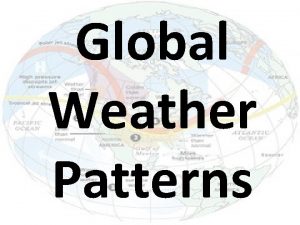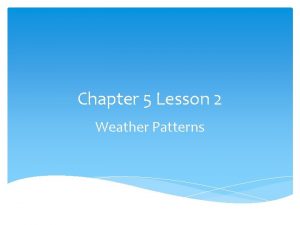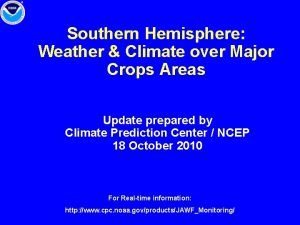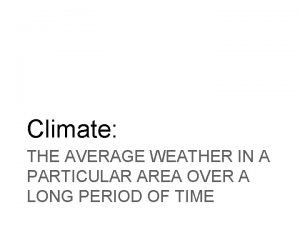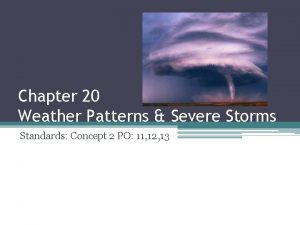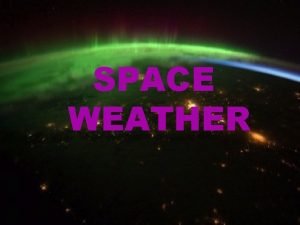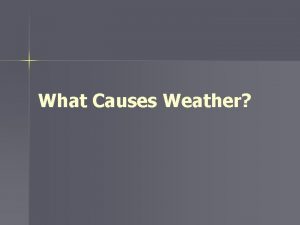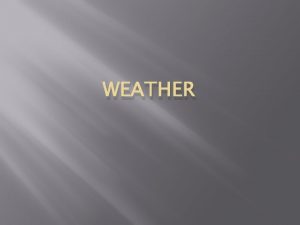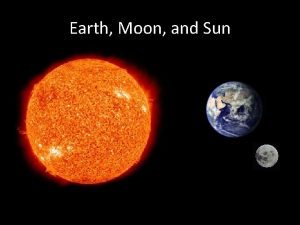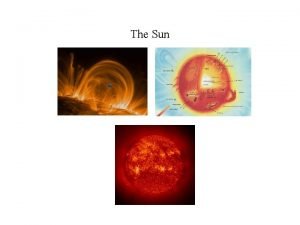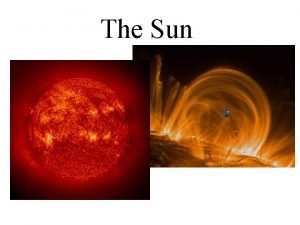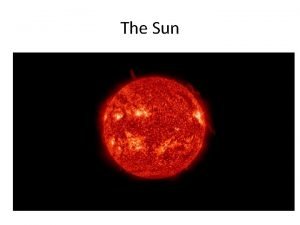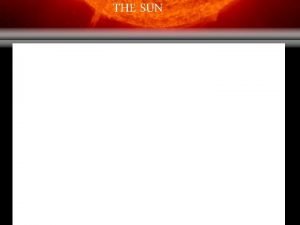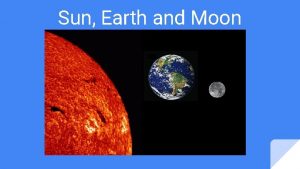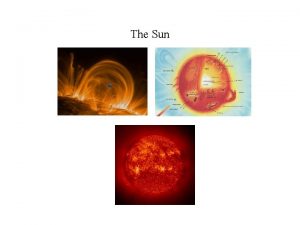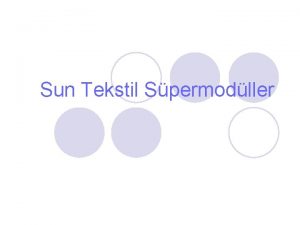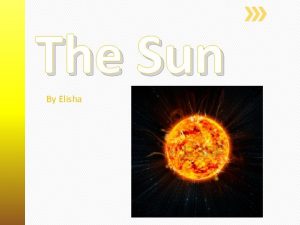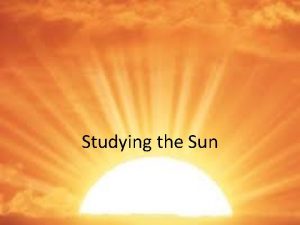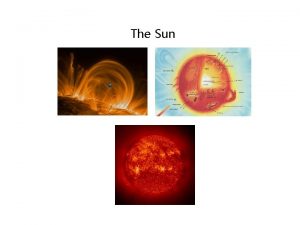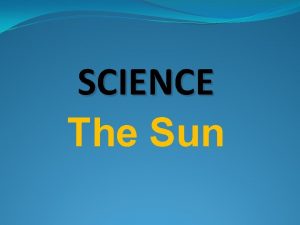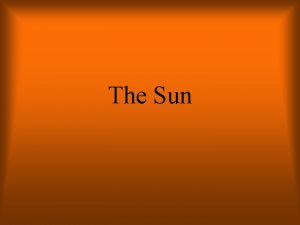Weather What causes weather patterns The sun The













































- Slides: 45

Weather

What causes weather patterns? • The sun! The sun is the source of almost all heat and energy. The sun heats air, which causes it to become less dense and rise and change temperature. • Remember… the tilt of the Earth in relation to the sun causes the seasons.

• Weather is the atmospheric conditions present in an area. • Weather is the day-to-day conditions of the air in a particular place. • The components of weather include: temperature, precipitation, wind, sunshine, visibility, air pressure, clouds, and location of the area.

Climate • Climate is the pattern of weather in an area over a period of many years.


Weather vs. Climate Weather • A short period of time • Short term changes in the atmosphere Climate • Long period of time • Long term weather pattern of a particular area Colorado Weather: Today it is sunny with a chance of rain. The temperature is 62 degrees. A PATTERN of weather Colorado (Fort Collins) Climate: dry winters with some snow, windy springs, low humidity winters, pleasant falls. Semiarid. Highly changeable weather.

Clouds

What are clouds made of? • Clouds - are made of tiny water droplets that condense from water vapor in rising air.

Different characteristics • Clouds have different characteristics because they form under different conditions and at different altitudes. Some cloud types and characteristics include:

Cirrus Clouds – wispy because they form in cold air at very high altitudes and are made of ice crystals – fair weather can be signs of a storm coming

Cumulus Clouds – puffy with flat bottom can have darker bases – Usually in the daytime in fair weather – If cumulus clouds keep growing taller, they can produce showers which changes the name to cumulonimbus clouds.

Stratus Clouds – Smooth/Layers because they form without strong air movement. – Usually make the whole sky appear to be gray – Low stratus clouds can be so dark that they completely block out the sun – Can produce steady, light precipitation

Cloud Prefixes or Sufixes • • • Cumulas = heaped or puffy Stratus = layers Cirros = high (above 20, 000 ft. ) Alto = middle (between 70, 000 ft. -20, 000 ft. ) Nimbo/Nimbus = Precipitation Virga = rain that falls from a cloud and does not hit the ground



Air Masses and Fronts • An air mass's temperature and humidity depend on the characteristics of the land or water over which it forms. • Air masses move and push each other. An air mass can be: – continental (dry) or maritime (moist), and – polar (cold) or tropical (warm) – Fronts form where air masses meet.


Cold Front • When the colder air mass pushes the warmer air mass, a steep cold front occurs. There may be thunderstorms along the front. • Symbol: solid line with triangles along the front pointing towards the warmer air

Warm Front • When the warmer air pushes the colder air, a warm front occurs. There may be overcast skies and steady precipitation. • Symbol: solid line with semicircles pointing towards the colder air.

Stationary Front • When the boundary is not moving, it is called a stationary front. • Symbol has both the cold front (triangle) and the warm front (semicircle) symbols.

Occluded Front • Front forms as the cold air behind the cold front meets the cold air ahead of the warm front. • Symbol: solid purple line with alternating triangles and semicircles.

Two types of pressure systems – High-pressure systems = weather that form around a high-pressure center. Fair weather usually results. – Low-pressure systems often form where air masses meet. Rising air at the fronts and at the low can cause stormy weather.


• A thunderstorm is a storm with lightning and thunder. • It’s produced by a cumulonimbus cloud, usually producing gusty winds, heavy rain and sometimes hail.

• The basic ingredients used to make a thunderstorm are moisture, unstable air and lift. • You need moisture to form clouds and rain. • You need unstable air that is relatively warm and can rise rapidly. • Finally, you need lift. This can form fronts, sea breezes or mountains.

• Thunderstorms can occur year-round at all hours. But they are most likely to happen in the spring and summer months and during the afternoon and evening hours.

• It is estimated that there around 1, 800 thunderstorms that occur across our planet every day.

• All thunderstorms are dangerous. Every thunderstorm produces lightning, which kills more people each year than tornadoes.


Tornadoes • A tornado is a violent rotating column of air extending from a thunderstorm to the ground. The most violent tornadoes are capable of tremendous destruction with wind speeds of up to 300 mph.

• Most tornadoes form from thunderstorms. You need warm, moist air from the Gulf of Mexico and cool, dry air from Canada.

• When these two air masses meet, they create instability in the atmosphere. A change in wind direction and an increase in wind speed with increasing height create an invisible, horizontal spinning effect in the lower atmosphere. • Rising air within the updraft tilts the rotating air from horizontal to vertical. An area of rotation, 2 -6 miles wide, now extends through much of the storm. Most strong and violent tornadoes form within this area of strong rotation.

When do they happen? • Tornadoes can happen at any time of the year and at any time of the day. In the southern states, peak tornado season is from March through May. • Peak times for tornadoes in the northern states are during the summer. A few southern states have a second peak time for tornado outbreaks in the fall. Tornadoes are most likely to occur between 3 p. m. and 9 p. m.

• The geography of the Great Plains, located in the central United States, is suited to bring all of the ingredients together to form tornadoes. • The Great Plains are also known as Tornado Alley. More than 500 tornadoes typically occur in this area every year. Texas, Oklahoma, Kansas, Nebraska, South Dakota, North Dakota, Iowa, Missouri, Arkansas and Louisiana all make up Tornado Alley.


• A hurricane is a huge storm! It can be up to 600 miles across and have strong winds spiraling inward and upward at speeds of 75 to 200 mph. • Each hurricane usually lasts for over a week, moving 10 -20 miles per hour over the open ocean.

• Hurricanes gather heat and energy through contact with warm ocean waters. Evaporation from the seawater increases their power. • Hurricanes rotate in a counter-clockwise direction around an "eye" in the Northern Hemisphere and clockwise direction in the Southern Hemisphere. • The center of the storm or "eye" is the calmest part. It has only light winds and fair weather. When they come onto land, the heavy rain, strong winds and large waves can damage buildings, trees and cars.

• Hurricanes only form over really warm ocean water of 80°F or warmer. The atmosphere (the air) must cool off very quickly the higher you go. Also, the wind must be blowing in the same direction and at the same speed to force air upward from the ocean surface. • Winds flow outward above the storm allowing the air below to rise. Hurricanes typically form between 5 to 15 degrees latitude north and south of the equator. The Coriolis Effect is needed to create the spin in the hurricane and it becomes too weak near the equator, so hurricanes can never form there.



What is a storm surge? • Storm surges are frequently the most devastating element of a hurricane.

What is a storm surge? • As a hurricane’s winds spiral around the storm, they push water into a mound at the storm’s center. This mound of water becomes dangerous when the storm reaches land because it causes flooding along the coast. The water piles up, unable to escape anywhere but on land as the storm carries it landward. • A hurricane will cause more storm surge in areas where the ocean floor slopes gradually. This causes major flooding.


Hurricane Seasons • The Atlantic hurricane season is from June 1 to November 30, but most hurricanes occur during the fall months. • The Eastern Pacific hurricane season is from May 15 to November 30.

Who names hurricanes? (This is just for fun, you won’t be tested over the naming of hurricanes. ) • From 1950 to 1952, tropical cyclones of the North Atlantic Ocean were identified by the phonetic alphabet (Able-Baker. Charlie-etc. ), but in 1953 the US Weather Bureau switched to women's names. T • he rest of the world eventually caught on, and naming rights now go by the World Meteorological Organization, which uses different sets of names depending on the part of the world the storm is in. • Around the U. S. , only women's names were used until 1979, when it was decided that they should alternate a list that included men's names too. There's 6 different name lists that alternate each year. If a hurricane does significant damage, its name is retired and replaced with another.
 Ultimate cause of behavior
Ultimate cause of behavior Social behavior examples in animals
Social behavior examples in animals What factor causes global wind patterns
What factor causes global wind patterns Obj dating
Obj dating X videos
X videos Cpalms what causes weather
Cpalms what causes weather Chapter 20 weather patterns and severe storms
Chapter 20 weather patterns and severe storms Local weather patterns
Local weather patterns Unit 6 lab 6-5 weather patterns answer key
Unit 6 lab 6-5 weather patterns answer key Tropical rainforest weather patterns
Tropical rainforest weather patterns Global weather patterns
Global weather patterns Lesson 2 weather patterns answer key
Lesson 2 weather patterns answer key Southern hemisphere weather patterns
Southern hemisphere weather patterns The average weather patterns for a particular region
The average weather patterns for a particular region Chapter 20 weather patterns and severe storms
Chapter 20 weather patterns and severe storms Weather stations symbols
Weather stations symbols Tongue twister winter
Tongue twister winter Poem about weather and climate
Poem about weather and climate Noun of windy
Noun of windy Weather vs whether
Weather vs whether Heavy weather by weather report
Heavy weather by weather report Capital weather gang weather wall
Capital weather gang weather wall Hát kết hợp bộ gõ cơ thể
Hát kết hợp bộ gõ cơ thể Ng-html
Ng-html Bổ thể
Bổ thể Tỉ lệ cơ thể trẻ em
Tỉ lệ cơ thể trẻ em Gấu đi như thế nào
Gấu đi như thế nào Tư thế worms-breton
Tư thế worms-breton Bài hát chúa yêu trần thế alleluia
Bài hát chúa yêu trần thế alleluia Môn thể thao bắt đầu bằng chữ đua
Môn thể thao bắt đầu bằng chữ đua Thế nào là hệ số cao nhất
Thế nào là hệ số cao nhất Các châu lục và đại dương trên thế giới
Các châu lục và đại dương trên thế giới Công thức tiính động năng
Công thức tiính động năng Trời xanh đây là của chúng ta thể thơ
Trời xanh đây là của chúng ta thể thơ Mật thư tọa độ 5x5
Mật thư tọa độ 5x5 101012 bằng
101012 bằng Phản ứng thế ankan
Phản ứng thế ankan Các châu lục và đại dương trên thế giới
Các châu lục và đại dương trên thế giới Thơ thất ngôn tứ tuyệt đường luật
Thơ thất ngôn tứ tuyệt đường luật Quá trình desamine hóa có thể tạo ra
Quá trình desamine hóa có thể tạo ra Một số thể thơ truyền thống
Một số thể thơ truyền thống Cái miệng nó xinh thế
Cái miệng nó xinh thế Vẽ hình chiếu vuông góc của vật thể sau
Vẽ hình chiếu vuông góc của vật thể sau Nguyên nhân của sự mỏi cơ sinh 8
Nguyên nhân của sự mỏi cơ sinh 8 đặc điểm cơ thể của người tối cổ
đặc điểm cơ thể của người tối cổ Thế nào là giọng cùng tên?
Thế nào là giọng cùng tên?







